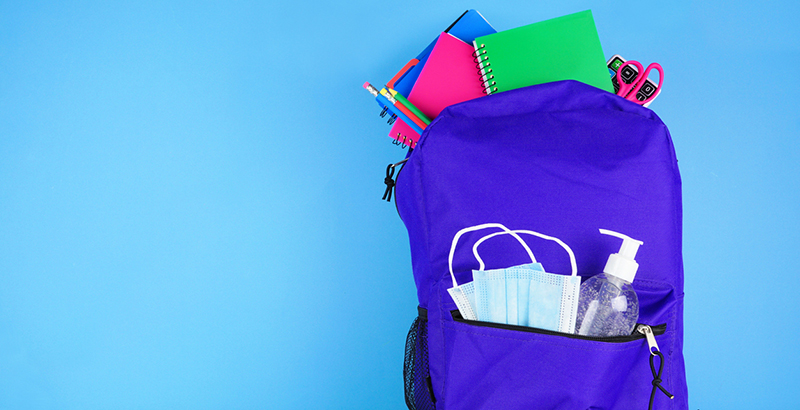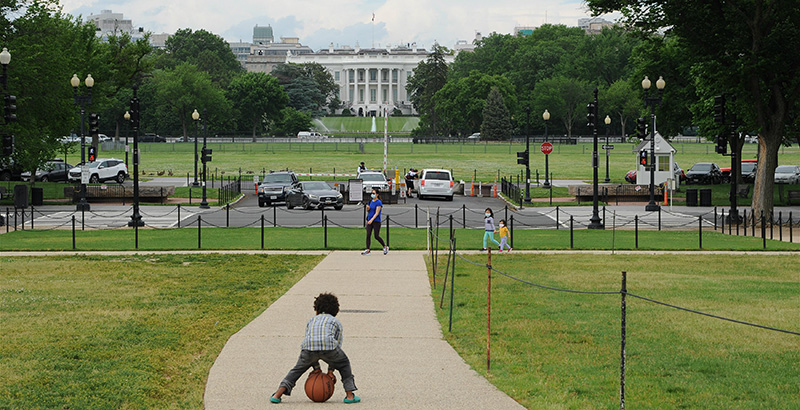U.S. Faces ‘School Attendance and Graduation Crises’
A weekly roundup of headlines about how the pandemic is shaping schools and education policy, vetted by AEI Visiting Fellow John Bailey

This is our weekly briefing on the pandemic, vetted by John Bailey. Click here to see the full archive.
This Week’s Top Story

The Nation Faces ‘School Attendance and Graduation Crises’
- Via Governing
- “For K-12 students, chronic absence, generally defined as missing 10% or more of school days, has escalated into a ‘full-scale crisis’ since 2019, says a new report from the nonprofit Attendance Works, with two- and threefold increases in many states. The levels are highest among low-income and minority students, it says, from the same communities most affected by the pandemic in other ways.”
- “ ‘Almost 10% of the school population seems to have disappeared,’ says Daniel Domenech, executive director of the American Association of School Administrators.”
- “States can play an important role in reducing chronic attendance by taking steps such as adopting common standards for measuring attendance, investments in data quality, expanded metrics and publishing disaggregated data, says [Hedy Chang, the founder and executive director of Attendance Works]. ‘We can make data even more meaningful in the future, so people can use it for allocating resources or identifying best practices.’ ”
- “Solutions will vary from school to school and family to family and, until COVID-19 moves further into the background, some might not be fully in the hands of schools, says [Data Quality Campaign’s] Paige Kowalski. But regardless of why a student didn’t come to school, simply knowing that they didn’t is critical.”
The Big Three — July 15, 2022
Americans Reflect on Nation’s COVID-19 Response
- Via Pew Research Center
- “Majorities of both Republicans (69%) and Democrats (57%) say the country has given too little priority to meeting the educational needs of K-12 students.”
- “When it comes to the central goal of protecting public health, Americans have decidedly mixed views: 43% say the country has given about the right amount of priority to protecting public health, while 34% say this has received too little priority and 21% say it has received too much.”
- “The overall findings reflect two competing critiques of the nation’s response. One, widely expressed among Republicans, is that the country has not focused enough on business concerns and respecting individual choices. The other, more widely held by Democrats, centers concern around efforts to protect public health and limit health risks for vulnerable populations.”
COVID Learning Loss Has Been a Global Disaster
- Via the Economist
- “When COVID-19 first began to spread around the world, pausing normal lessons was a forgivable precaution. No one knew how transmissible the virus was in classrooms; how sick youngsters would become; or how likely they would be to infect their grandparents. But disruptions to education lasted long after encouraging answers to these questions emerged.”
- “Locking kids out of school has prevented many of them from learning how to read properly. Before the pandemic, 57% of 10-year-olds in low and middle-income countries could not read a simple story, says the World Bank. That figure may have risen to 70%, it now estimates. The share of 10-year-olds who cannot read in Latin America, probably the worst-affected region, could rocket from around 50% to 80%.”
- “In many parts of the world, schools were closed for far too long.”
- “A paper published in May by analysts at the World Bank, Harvard and the Brookings Institution looks at 35 studies of learning loss from 20 mostly rich countries. It finds that the average loss across these studies was equivalent to what would usually be learned in one-third to one-half of a year of normal schooling.”
- “Schools in a quarter of countries still have no plans for catch-up, says UNICEF. Fewer than half of governments have scribbled strategies that are national in scale. Poor children are clawing back time more slowly than wealthier ones.”
Despite Urgency, New National Tutoring Effort Could Take 6 Months to Ramp Up
- Via Linda Jacobson in The 74
- “With a third pandemic summer underway, the Biden administration’s new push to recruit 250,000 tutors and mentors is getting a late start in helping students recover from academic and social-emotional setbacks. Organizers and experts say it could be 2023 before families and schools see the impact.”
- “ ‘We can’t mobilize fast enough,’ said Robert Balfanz, an education professor running the new National Partnership for Student Success, housed at Johns Hopkins University.”
- “Working with colleges, large employers like Starbucks and Target, and established nonprofit organizations serving youth, Balfanz said, should develop the partnership into the national tutoring corps that experts have been recommending for several years. AmeriCorps will also spend $20 million to help organizations recruit and train tutors.”
Federal Updates
White House
- Announces more than $40 billion in American Rescue Plan Investments in Our Workforce
- Shares strategy to manage BA.5 COVID variant (White House Briefing)
Internet for All
- National Telecommunications and Information Administration announced that all states and territories have confirmed their participation in the Internet for All initiative.
Department of Agriculture
- Partners with 27 states to issue child food benefits for the summer.
FDA Grants Full Approval to Pfizer COVID Vaccine for Ages 12-15
- “The [Food and Drug Administration] said [last week] the full approval follows a rigorous analysis and evaluation of the safety and effectiveness data. The vaccine was approved for use in those aged 16 and older in August last year.”
City & State News
Oklahoma
- Gov. Kevin Stitt calls for special audit of Tulsa Public Schools alleging that the district potentially mishandled COVID-19 relief funds and possibly broke state law by teaching critical race theory.
Illinois
- As teacher shortage worsens, schools cast wary eye on fall reopening.
California
- State public health officials announced guidance for the 2022-23 K-12 school year with no mask requirement for students or staff.
Colorado
- Report finds “the rate at which Colorado students are going to college right out of high school has dipped, and those who do go are less prepared. And participation in programs offering college experience in high school has remained stagnant.”
Hawaii
- Indoor masks will be optional at Hawaii public schools.
Idaho
- “Parents with income levels at or below $60,000 per year can apply for grants this summer created by the Idaho State Board of Education to help with their children’s education.”
COVID-19 Research
An Update on Variants
- Via Katelyn Jetelina
- “In Europe, BA.4/5 is driving a case surge. Hospitalizations in Portugal finally peaked and are well on their way down. Hospitalizations in other European countries continue to rise, though.”
- “In the U.K., it’s clear that hospitalizations [are rising] both with and for COVID-19. The distribution seems to be stubbornly consistent since a switch during the first Omicron wave last winter, when hospitalizations for COVID-19 took the lead.”
- “BA.2.75 carries eight additional mutations on the spike protein compared to BA.2. There are two mutations in particular that are cause for concern: G446S and R493Q. G446S is at one of the most potent sites of escape from antibodies. As the Bloom Lab interestingly pointed out in the figure below, BA.2.75’s impact will be dependent on infection history. Among those with a previous BA.1 infection, the probability of immune escape at spot 446 (and thus infection) is lower than those without a previous infection.”
- “This makes the fall booster conversation interesting. Last week, the FDA authorized a BA.4/5 vaccine formula. However, one could make the argument that the original BA.1 vaccine formula would be better with this BA.2.75 news. But, chasing variants is never going to work. Our goal should be [to] broaden protection. An Omicron vaccine will do that, regardless of the subvariant circulating.”
- Related via CIDRAP: “Relative to BA.2, the BA.2.12.1 subvariant was about 80% more resistant (1.8-fold) after three vaccine doses, but BA.4 and BA.5 were at least 4.2 times more resistant, increasing the likelihood of breakthrough infections.”
- More: Andy Slavitt’s take on the new BA2.75 variant
Moderna Omicron Shots
- Moderna will advance two Omicron vaccine candidates, one designed against the BA.1 variant and another against the BA.4 and BA.5.
Approved At-Home Test for COVID and Influenza
- “The FDA green-lights combination at-home test for COVID and influenza in children as flu season approaches.”
- Labcorp press release
Kids Have Stronger COVID-19 Antibody Response Than Adults
- New JAMA study and more details via CIDRAP
- “Children younger than 3 years were found to develop higher levels of binding antibodies compared with adults older than 18 years.”
Viewpoints and Resources
National School Pulse Survey
- New results from the National Center for Education Statistics
- 87% of public schools reported that the COVID-19 pandemic has negatively impacted student socio-emotional development during the 2021-22 school year
- 72% report an increase in chronic absenteeism
- 77% reported that finding substitute teachers has become more difficult during the pandemic
Strategies for Healthy Buildings
- Resource from The Lancet COVID-19 Commission Task Force on Safe Work, Safe School, and Safe Travel: The First Four Healthy Building Strategies Every Building Should Pursue to Reduce Risk from COVID-19
Half of Parents Likely to Follow Pediatrician’s Advice on COVID-19 Vaccination
- According to results published in Academic Pediatrics
- “More than 30% in all groups agreed with the statement that COVID-19 vaccines might cause lasting health problems for their children.”
Education Recovery After COVID-19
- Via OECD
- “Children have been the least vulnerable to COVID-19, but no group has been harder hit by public policy responses to contain this virus. Emerging evidence shows how long school closures have had devastating effects on many children’s cognitive, social and emotional well-being.”
- “Besides the sheer cognitive and socio-emotional loss to each child of missing so much time to learn and interact with teachers and friends, lost learning itself generates long-term consequences for each person and society as a whole: poorer job opportunities and lower income for individuals, and lower productivity for the economy.”
- “Importantly, the data from the OECD, UNESCO, UNICEF and World Bank survey show no relationship between the extent of school closures and COVID-19 infection rates across countries. This shows that school closures were not inevitable but, rather, a policy choice, often framed by a lack of institutional capacity to reconcile educational provision with health and safety.”
…And on an Inspiring Note
Duke Women’s Basketball
- “Be someone who handles hard better.”
- “We wait in life for things to get easier.”
- “It will never get easier. What happens is that you handle hard better.”
- “So make yourself a person that handles hard well. Not someone who waits for the easy.”
- “Because if you have a meaningful pursuit in life, it will never be easy.”
ICYMI @The74
Weekend Reads: In case you missed them, our top stories of the week:
- New Study: Black, Special Education Students Punished at Greater Rate Through Pandemic
- 74 Interview: Harvard Economist Offers Gloomy Forecast on Reversing Pandemic Learning Loss
- Resource: Education Researcher Creates Free Summer Reading Program for Parents
For even more COVID policy and education news, subscribe to John Bailey’s daily briefing via Substack.
Disclosure: John Bailey is an adviser to the Walton Family Foundation, which provides financial support to The 74.
Get stories like these delivered straight to your inbox. Sign up for The 74 Newsletter

;)
